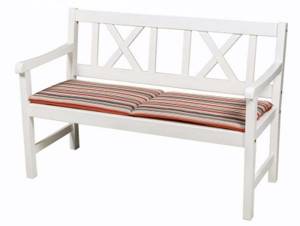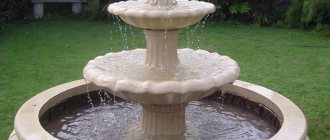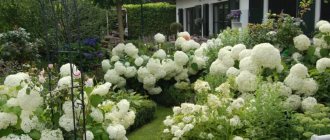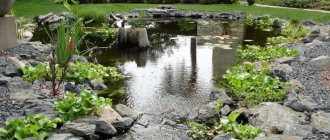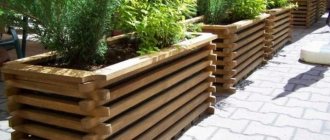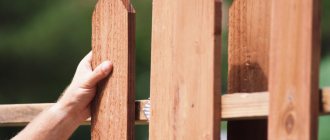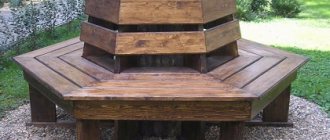Choosing material for the bench
The location of the garden bench in the fresh air requires a number of material requirements for the accessory. Such products must have the following qualities:
- Strength of the structure.
- Resistance to moisture and temperature changes.
- Resistance to fungi and parasites.
- Long service life.
In addition, in terms of aesthetic characteristics, the bench should fit well into the overall interior of the garden.
- Wooden benches.
- Metal products.
- Plastic garden benches.
- Products made of decorative stone.
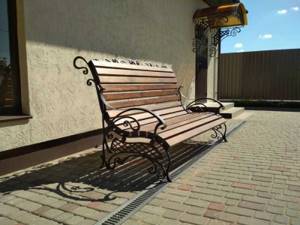
Some models can be made independently with minimal construction skills, but plastic benches can be purchased at any large furniture store.
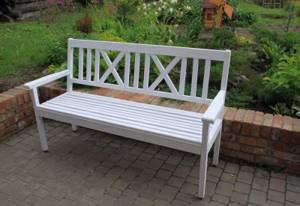
Benches made of plastic
Plastic benches are much cheaper than all the others, and sometimes they look no worse than wooden or metal ones. Some are even specially stylized as wooden benches. But look closely, they are actually made of plastic.
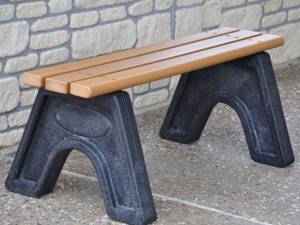
If you don't have enough color in your garden, then a plastic bench is your option. They come in a variety of colors, so that the most “boring” place in the garden will immediately become the most attractive. But keep in mind that bright plastic benches can fade in the sun.
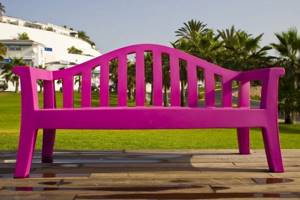
Sometimes you can find unusual and even surprising specimens among plastic benches.
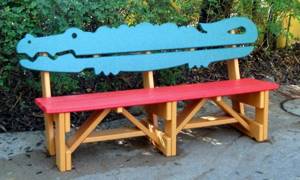
And sometimes – stylish and original.
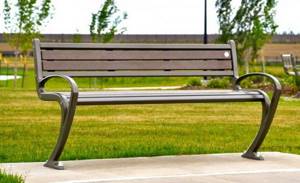
Wooden garden bench
Natural wood is a rich material, natural color and pattern. However, without special treatment, the structure is easily damaged by moisture and pests.
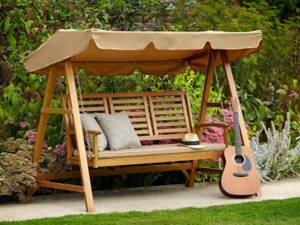
If the technician is expected to work independently, it is best to stock up on the appropriate reagents - antiseptic solutions and antifungal agents.
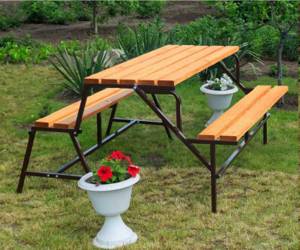
What kind of benches are there?
The most common are ordinary wooden benches with a back. They are quite easy to assemble and look pretty decent.
Forged benches look beautiful, and they last for many decades. However, to make them you need to have specific skills and tools.
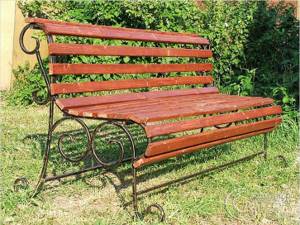
Bench with forging
Seats made of various types of stone. It is with the help of this material that it is convenient to create very interesting combinations. The disadvantage of such structures is that in winter you cannot sit on it for a long time. In addition, it will not be possible to move the “furniture”.
Wooden seats are considered the best option for independent creativity. The wood is easy to process and available. It is easy to make a bench of any shape and style. For example, a simple bench can be made from an old trunk by simply sawing it into two equal parts.
To work, you will need a certain set of tools, however, the most common are:
- saw,
- plane,
- jigsaw,
- sandpaper,
- construction pencil and tape measure,
- a hammer with nails or a screwdriver with self-tapping screws.
Note!
The thickness of the boards intended for sitting is desirable 25 mm. You can take it thicker, but it is the twenty-five-millimeter surface that pleasantly springs under a person’s weight and provides comfort. An important condition should be the absence of knots, at least large ones, that reduce strength.
Let's take a closer look at several types of garden structures.
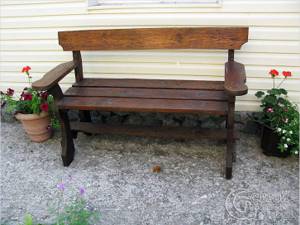
Small bench near the house
One of the simplest is a rural type bench . Textured curved boards are perfect for it. On the one hand, they should be smoothly planed so that they are comfortable to sit on. Using a plane, their edges are trimmed and given a rounded appearance. If the workpieces contain cracks, this will only add an original appearance to the product. The damage can even be increased slightly for greater effect. After adjusting the dimensions, the parts need to be impregnated with an antiseptic and sanded. For the bench you need to select one or more narrow boards, preferably without surface defects. Two strong bars are perfect for the legs.
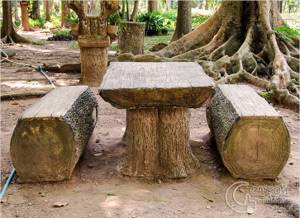
The simplest benches made of logs
The second option is even simpler. The bench is made from a single piece of wood . This is not only creative, but also very practical. The main condition here is that the tree trunk has a suitable diameter. In addition, you need to look at the side branches. It’s good if they grew almost perfectly one above the other. Therefore, selecting source material is not easy. And to get the bench itself you don’t need many tools: sandpaper, saw, stain, antiseptic and varnish. The log must be cut exactly in the center. The upper part can be used for firewood, but the lower part can be processed further. Ideally, only those branches that are intended to serve as supports are pruned. Even if they are crooked or beveled, this will only give the item a special charm.
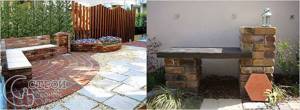
On a brick base
A simple and solid bench can be made from just a few bricks and one board . Masonry is needed for support legs. The height of the columns should be approximately 7 blocks. You need to leave a small recess at the very top; the flat seat will then be fixed in it. To decorate the sides of such a structure, you can install flowerpots for flowers.
The most difficult option would be a transformable bench , which quickly turns from an ordinary sofa into a garden table with benches. True, you will have to think about the drawing, but it is worth it. Such a bench will consist of two parts: a bench and a backrest that can be moved. And it is this backrest, when tipped over, that will serve as a tabletop. The main problem in this case is reliable fastening of the moving components. To make the structure stable, it is better to lower the seat lower and place the supports wider.
Metal benches
Metal benches can be purchased in the store - cast forms, decorative finishes in gold, brass or any other coating. But you can also make a garden bench yourself. The master will need:
- Finished drawing.
- Welding machine.
- Old pipes, fittings or sheet metal.
- Materials for decorative finishing (paints, varnishes, brushes).
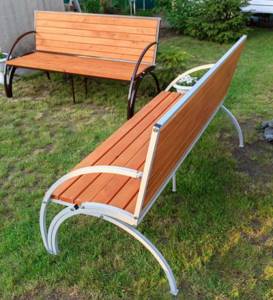
There are models with a solid seat and back, molded lattice options and benches without a back. Metal benches require special treatment against corrosion, but in general, they are resistant to moisture and mechanical damage.
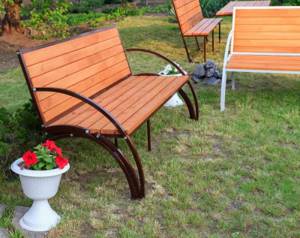
Unusual DIY garden bench
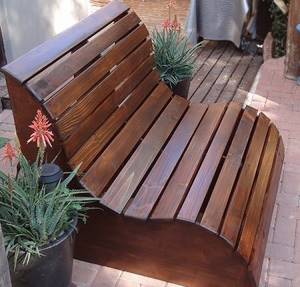
Sometimes you wonder how a simple bench can decorate a garden or add zest to a terrace. And this is exactly what happened with our shop. The streamlined design and luxurious luster of the wood exceeded all expectations. This design is quite simple, but still suitable for a master with existing skills in such work. We used plywood for the solid shaped parts, and covered the bench with pine slats.
So, if you were inspired by the photographs of our detailed master class, prepare everything you need and get to work quickly.
In order to make a garden bench with your own hands today you will need:
1. Materials:
- plywood for the manufacture of the supporting structure (we used sheets 900 x 900 mm, 16 mm thick); - pine slats, 140-150 cm long; - a couple of scraps of pine board to connect the middle load-bearing part (in our case it turned out to be composite, because there was not enough material for a solid one); - wood glue; - wood screws; - wood putty; — decorative coating for wood;
2. Tools:
- jigsaw; - electric drill; - screwdriver; - Sander; - construction tape - ruler; - paint brush; - putty knife; - pencil.
Gather all materials, prepare tools and work area. During the summer season, you can work outside under a canopy.
Step 1: Making the base parts
Start by making the bench base pieces. It will consist of 3 figured parts and three pine slats that will connect them to each other.
For the curly elements we used plywood. After treatment with a protective decorative coating and careful use, it will last for quite a long time. If we decided to use wooden boards for these purposes, we would first have to make a shield by gluing them together and fixing the groove into the groove. This is a complex and time-consuming job, and that is why the choice fell on ready-made sheet material.
To draw the shapes of the required shape, we used the top of a coffee table. If you want, you can build patterns on cardboard or wallpaper, cut them out and only then transfer the design to the material. The height and width of the elements must be at least 90 cm. Their thickness was 16 mm.
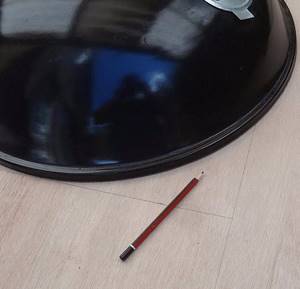
For reliability, the design includes three shaped parts, but we didn’t have enough material for the third solid part. In order not to buy another sheet of plywood, we made a composite of two parts, which were connected together with scraps of wooden slats.
Cut out the parts along the contour using a jigsaw. Mark three grooves for wooden blocks on each workpiece and cut them out.
Prepare bars for the supporting structure. To do this, cut a pre-prepared narrow board into 140 cm pieces. You should have 3 such parts. Sand them with a sanding machine before connecting all the elements together. Also sand the edges of the plywood pieces.
Step 2: preparing the slats
Prepare slats 150 cm long - this is 10 cm longer than the supporting structure. Sand them with a sander to prepare the wood surface for painting.
Step 3: assembly of the structure
Connect 3 shaped blanks with bars, using self-tapping screws and coating the joints with wood glue. To prevent the bars from cracking when screwing in the screws, use an electric drill and pre-drill holes for fastenings in them.
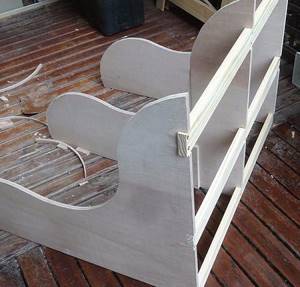
Proceed to screwing the slats. Also drill holes for self-tapping screws in each of them.
The design is basically ready. Therefore, you can sit down for now and test it for convenience and reliability.
Step 4: Finishing
Fill the screw heads with wood putty. We will be painting the bench in a darker tone, so we boldly used dark brown. Wait until completely dry.
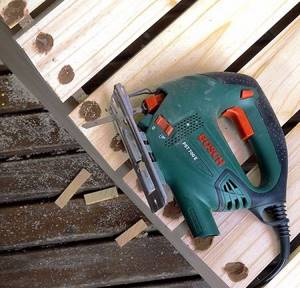
Proceed with final sanding. Pay special attention to the fastening areas. Carefully round the transverse ribs of the slats along the edges. Clean the bench of shavings and wood dust. If necessary, wipe it with a damp, clean cloth and proceed to painting.
We used an oil-based wood varnish with a beautiful dark brown undertone. You can do the same, or you can choose any paint and varnish material at your discretion: paint with a dense coating, decorative oil, natural linseed oil or drying oil, stain. Or use several coatings at once. For example, stain and varnish or paint and varnish and so on.
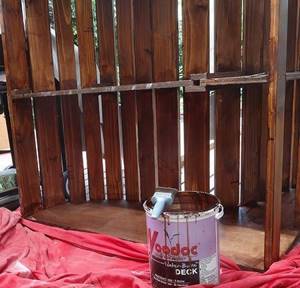
Please note that when using varnish or paint, it is better to apply the coating in several layers at once and lightly sand it with fine-grained sanding paper so that each new layer penetrates deeper into the previous one. Thus, you will receive a coating that is resistant to weather conditions and mechanical damage, and the bench will serve you for several years without repair.
The garden bench is ready and our master class has come to an end. We really hope that it inspires you to new beginnings and creating wonderful crafts!
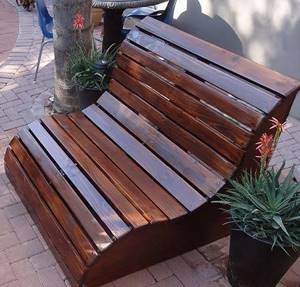
Source
Become the author of the site, publish your own articles, descriptions of homemade products and pay for the text. Read more here.
Plastic benches
This type of bench has many advantages in practice:
- A light weight.
- A wide variety of models of different shapes, colors and sizes.
- Low cost of products.
- Resistant to moisture.
- Mechanical strength.
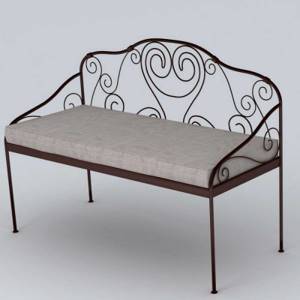
Benches made of decorative stone
At the request of the garden owner, you can use both natural stone and artificial types of material. Finding drawings of finished benches for subsequent work will not be difficult - photos of finished products can be found in any landscape design magazine.
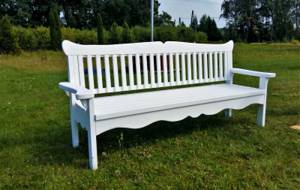
Stone as a material has excellent qualities:
- Strength of the structure.
- Beautiful view.
- Not afraid of moisture and damage.
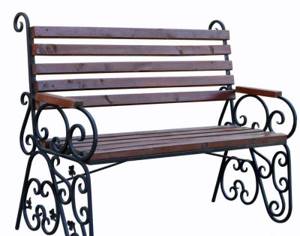
To create such a bench you will need drawings, construction tools and a minimum of knowledge about stone laying.
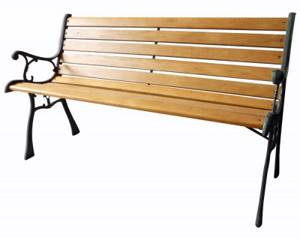
Types of garden benches
Today the most famous models among garden tools are:
- Bench without back.
- Garden bench with backrest.
- Bench with table.
- Bench with canopy.
- Garden bench with built-in flowerpot.
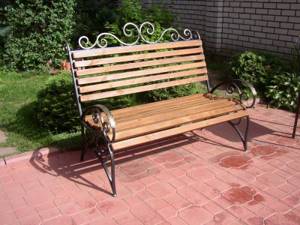
Each model presented has its own drawings, manufacturing methods and materials used primarily in the work.
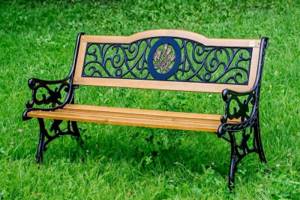
Additional functionality – awnings over benches
If there are no shady areas on the site, then an additional canopy can be provided for protection from the sun. Let's look at several options for its implementation.
The canopy can be installed separately or made part of the structure, as in the presented photo. Here we see 4 racks made of timber, on which the top trim is made. The roof is formed by boards installed on edge - the classic form of a pergola. Lath trellises were added to the sides of the structure. All this will become a reliable basis for climbing plants, which after a while will provide beautiful and cool shade.
Pergola canopy
Installing a large canopy can be made from a simple bench into a swing.
This functionality will be appreciated by both adults and children. Bench with a wooden canopy in the form of a swing
Garden bench with back
This option is comfortable, so it has become more widespread. Materials for independent work are wood and metal profiles.
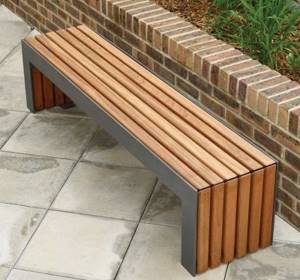
Only combined options can be made from decorative stone - with a wooden or forged metal back. Plastic models of benches are presented in a large assortment in stores, for example, in Leroy Merlin.
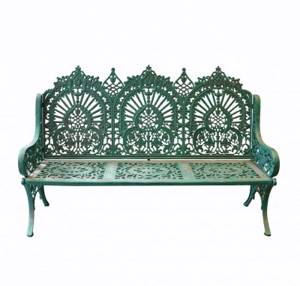
Bench with table
The manufacturing technology assumes the presence of a solid structure: the bench is connected by supporting mechanisms to the table frame. Most often, when creating such a model, natural wood with additional decorative finishing is used.
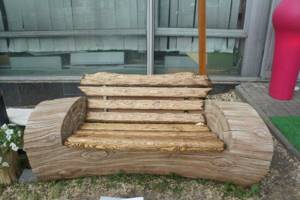
By placing a similar structure in your garden plot, you can safely invite guests to a party, since the bench is quite large in size.
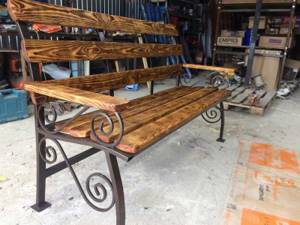
Garden bench with canopy
It is a kind of analogue of a miniature gazebo. The presence of a roof determines a number of advantages for practical use:
- Maximum stability.
- Rain protection.
- Ease of maintenance - the presence of a sloping roof does not allow dirt and debris to accumulate at the top.
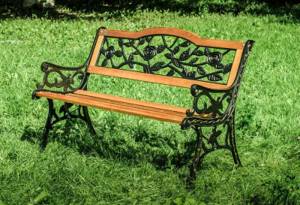
Having a ready-made diagram allows you to make such a bench yourself.
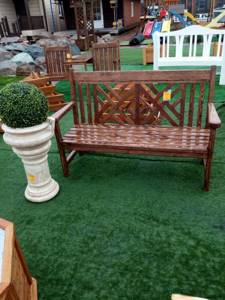
Bench with built-in flowerpot
An interesting author's idea for the aesthetic design of a garden plot. Instructions for the master on creating such a model:
- Choose a material (most often it is wood or decorative stone).
- Prepare a diagram.
- When carrying out construction work, prepare two niches for flowerpots. The depth of each niche should be sufficient for planting flowers. Bright annuals will look beautiful and original in such a flowerpot.
- It is imperative to provide for a drainage system and a system for the outflow of liquid.

A plant pot is an original idea that fits comfortably into the interior of a garden plot.
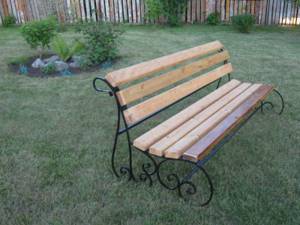
Wooden benches
It is very comfortable to relax on a wooden bench, because it quickly warms up in the sun. In this case, you can choose absolutely any design and color. For example, a white bench looks very stylish and strict against a background of greenery and flowers. If you have a blue fence, then you can paint the bench the same color. In general, imagination is not limited by anything.
By the way, painting the benches is not at all necessary. Sometimes an old bench looks much more impressive in the garden than a new one. It’s not for nothing that you can find benches decorated in antique style on sale. By the way, they are very popular among summer residents.
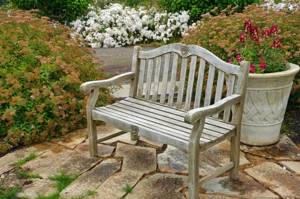
If you love everything unusual, then you will definitely love these amazing benches. It would seem that there is nothing complicated in the ideas presented below, but how great these benches with a “twist” will look in the garden!
Wood is a fertile material for creating benches, because you can cut a variety of fancy shapes from it. If you know how to work with wood or know a master, then you may well become the owner of a bench that no one else will have.
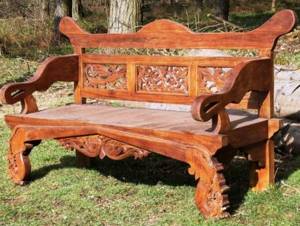
Wooden “sofas” look very interesting on the site. Of course, they are more suitable for patios, where they can be accompanied by wooden tables in the form of cubes, and the area itself can be protected from rain. But if there is such an opportunity, then why not take advantage of it?
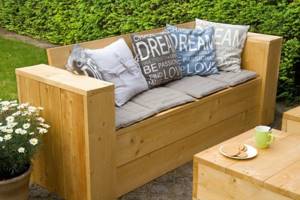
Requirements for the construction of a garden bench
When making garden benches, a number of requirements must be met:
- Design safety. The bench model must be able to withstand quite a lot of weight.
- Sustainability. When creating a bench, it is necessary to make strong supports that will hold the structure on the ground without the possibility of falling.
- Comfort. The bench should be as comfortable as possible. As you know, all furniture manufacturers focus on the anatomical features of the human body when creating products. When working independently, it is best to do the same.
- Resistant to moisture. High humidity, rain, snow, fog - these are weather conditions that can damage garden furniture without prior special treatment of the products.
- Resistant to temperature changes. The surface of the garden bench should not crack due to rapid changes in degree gradient.
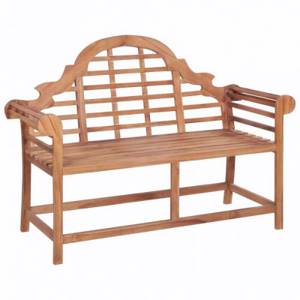
By observing these requirements and providing methods for protecting products from harmful factors, you can create a durable, convenient design with maximum service life.
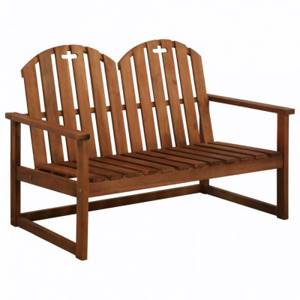
Design features
Before making complex designs, it makes sense to consider the drawings of an ordinary bench. It can be presented as:
We suggest you familiarize yourself with How to install a damper in a sauna stove
- Standard model with two to four legs and a seat;
- Improved model with legs, seat and back;
- A more unique model, which is complemented by armrests.
Wooden benches are an ideal solution if you need to install furniture in an open space. An item that is constantly in such conditions must meet a number of criteria:
- strength;
- resistance to temperature changes and precipitation;
- presentable appearance;
- possibility of repair;
- ease of care.
A high-quality product, manufactured in accordance with all the rules, will certainly meet the listed requirements.
The material from which such furniture is created (that is, wood) is valued for its advantages:
- practicality. It has low thermal conductivity, so it does not freeze or overheat depending on the weather. In addition, the material is pleasant to the touch;
- strength. A bench made of wood can last for quite a long time;
- environmental friendliness. The material does not emit harmful substances and is therefore not dangerous to the health of people and pets;
- aesthetics. The natural appearance of wood is valuable in itself due to its rich color and natural pattern. In this case, the surface of the material can always be painted in any shade.
DIY Tools
To make a bench yourself, you will need not only drawings of benches, but also a certain set of tools. The most common work available to an inexperienced craftsman is wooden benches.
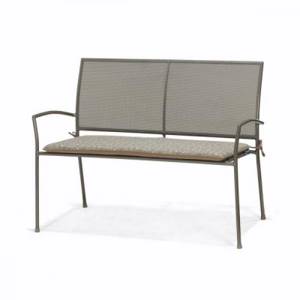
To work you will need to prepare:
- Blanks in the form of wooden boards. The number of blanks depends on the size of the bench and backrest.
- Blanks for support and armrests (if they are provided according to the drawing).
- Materials for strengthening the bench, wood beams are most often used.
- Electric saw, screws or nails.
- Acrylic varnish and paint for decorative finishing.
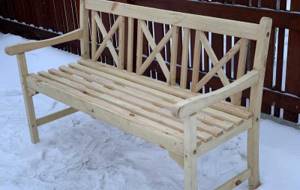
This list may vary depending on the type of work, style, model, size.
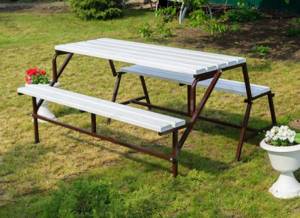
Locations and views
A garden bench has several “legitimate” places where you cannot do without it.
Summer bench in a shady place
A place to rest in the shade will be a welcome respite in the middle of a hot summer day. It can be found on the north side of the house, under the spreading crown of trees, in an ivy-covered gazebo. Place the bench with its back against a wall, hedge, tree trunk - if the space behind is closed, a person feels more comfortable.
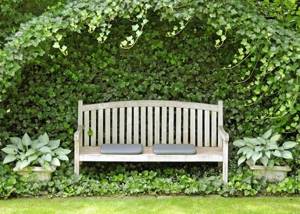
A cozy “grotto” made of ivy creates the desired shade and reliable protection from the “rear”
Bench for privacy
You should have a place where you don’t take guests, but go there alone. This is your secret refuge, where it’s nice to sit in silence, get away from everyday problems, read, and dream. It is advisable to find a corner in which you would be closed from prying eyes, but at the same time you could see if someone was approaching.
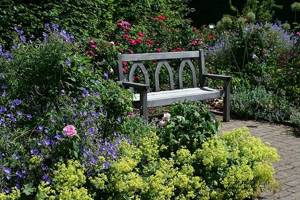
Sitting on this bench, you will see the first blossoming flower and feel its sweet aroma
View bench
Find “strategic” points in your garden from which the most successful plant groups and attractive corners are visible, and place benches here. What is worth admiring? Garden compositions with a one-way view, flower beds, an alpine slide, a pond, beautiful surroundings (if any).
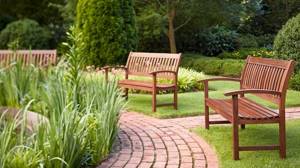
View benches
Bench by the water
The measured murmur of water calms and puts you in a philosophical mood. It’s nice to sit by a picturesque pond or a clear stream after a hard day, relax, watch the fish and dragonflies, and recharge with the energy of nature. Therefore, if there is a water composition in the garden, there should definitely be a bench on the shore.
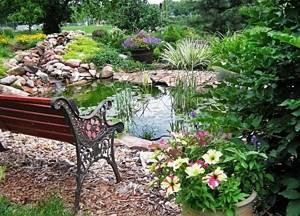
From the bench you can see the mirror of the pond and the picturesque rocky composition
Circular bench
If there is a large old tree on the site, you can equip a bench by placing it around the trunk. This will give an excellent all-round view, allowing you to change viewpoints depending on the season, lighting, and mood.
Not any tree will do, but only one whose crown is located high enough and does not block the view. It is recommended to fill the tree trunk circle with decorative crushed stone - it’s better for the roots, and the shoes will be clean in wet weather.
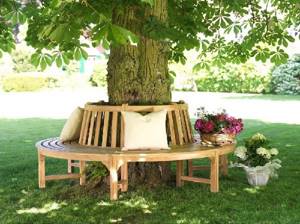
The circular wooden bench blends seamlessly into the surrounding landscape
Bench at the entrance
A traditional element of Russian estates is a bench at the entrance. Previously, it was intended not so much for the owners as for travelers passing by. Everyone could sit on it, drink water from the well, and share news. In villages today, it still serves as a “heap” where neighbors hold gatherings. You too can get something similar.
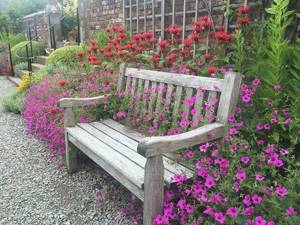
If you don’t want to invite a visitor into your home, you can resolve issues while sitting on a bench
Bench in the vegetable garden area
Who said you don't need furniture in your garden? Just the opposite. After hours of weeding, there is no greater pleasure than sitting down on a comfortable bench and soothing your aching back. Better yet, combine business with pleasure and install a bench with the exotic name “cash-punka”.
This is nothing more than a spacious chest in which the lid serves as a seat. Excellent storage for hoes, hoes and other garden tools.
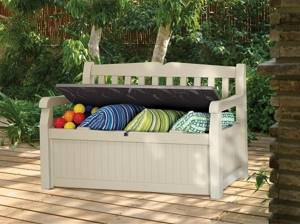
Multifunctional “punk cash register” - if you want, put it in the garden, or if you want, put it on the playground
Landscape design project from Sad-dizain
More details
Bench as an art object
Do you dream of a bench that is not only pleasant to sit on, but also interesting to look at? You can, of course, order designer furniture. Or you can, using your imagination, create interesting artistic compositions yourself with a garden bench in the leading role.
Use everything you have at hand - vases and baskets of flowers, hats, flower pots, wreaths of wild flowers, pillows, a beautiful shawl, gardening tools. And even though such a composition is short-lived, it is the result of your interaction with the garden. And this is the main thing.
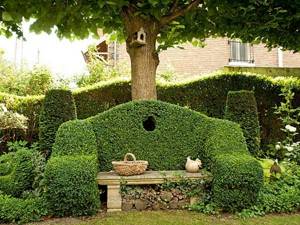
A hedge instead of a backrest is a non-standard solution
Interesting design ideas
A creative approach and maximum imagination sometimes bring completely unexpected results. The most interesting models today:
- Ring-shaped bench. The bench is arranged around a tree or stump.
- A bench in the shape of a bundle of bamboo. The seat is located in the center of the bundle.
- Particularly popular are models decorated with figures of animals or fairy-tale characters.
- Folding benches.
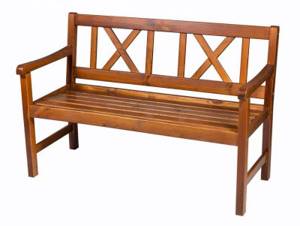
It is extremely difficult to make such benches yourself, so you will need the help of a landscape design specialist.
